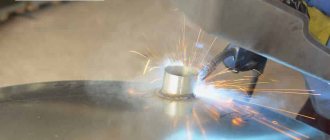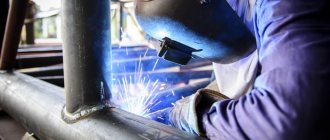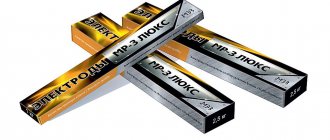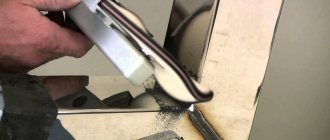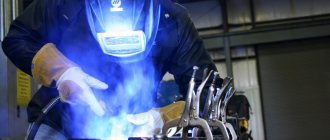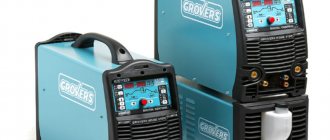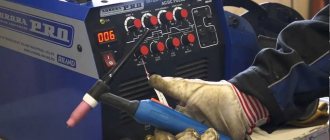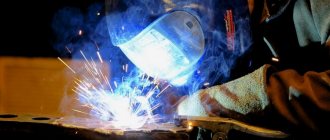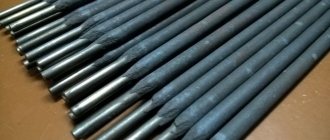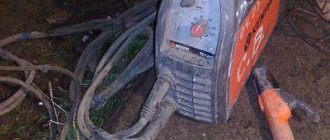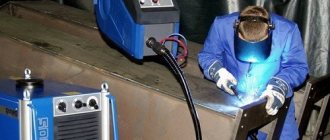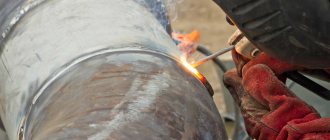02/20/2019 Author: VT-METALL
Issues discussed in the material:
- Who created stainless steel and when?
- What is the technology for welding stainless steel?
- What are the modes and methods of welding stainless steel?
- What equipment and consumables are needed for welding stainless steel?
- How to weld stainless steel products with other metals
- What are the most common mistakes made when welding stainless steel?
According to the existing classification of metals, stainless steel is highly alloyed, especially resistant to destruction and corrosion. The consumer sees this as a huge advantage, but the welder sees it as difficult to process. Today, welding of stainless steel pipelines and welding of thin-sheet stainless steel are in great demand. For a professional, performing this work should not be difficult. Let's take a closer look at what stainless steel welding is.
History of stainless steel
Stainless steel owes its appearance to the English metallurgist Harry Brearley, who in 1913 worked on improving gun barrels and noted that chromium added to low-carbon steel dramatically increases its anti-corrosion properties.
The main elements of any stainless steel are iron, chromium and carbon. The amount of chromium in the composition varies between 11–30%. High corrosion resistance of steel is ensured by chromium added in an amount of at least 12%. It is thanks to this that, when interacting with oxygen in the atmosphere, an oxide film is formed on steel, which is a very thin layer of chromium oxide. The atoms of this oxide are similar in size to chromium atoms, which allows them to tightly adhere to each other and form a layer that is resistant to any influence and has a thickness of several particles.
Stainless steel welding technology
Welding stainless steel is a process that requires a serious approach. Even a slight deviation from the developed technology threatens with a negative result. All requirements for techniques and methods of welding stainless steel are dictated by its chemical composition and physical properties.
We recommend articles on metalworking
- Steel grades: classification and interpretation
- Aluminum grades and areas of their application
- Defects in metal products: causes and search methods
For industrial or domestic welding of profile and sheet stainless steel, it is necessary to choose the right method of operation. It all depends on the type of metal. Professionals qualify stainless steel for:
- austenitic;
- martensitic;
- ferritic.
The efficiency of the stainless steel welding process is influenced by many factors.
Some features of the technology
The use of special semi-automatic welding machines mentioned above can significantly improve the quality of stainless steel welding, as well as simplify the process of its implementation. The use of such equipment allows you to solve several technological problems at once, including:
- supply of filler wire to the joint formation zone;
- supply of shielding gas to the welding zone;
- cooling of the welding torch;
- ensuring the convenience of making welded joints in hard-to-reach places.
Semi-automatic welding equipment
In products made of stainless steels, during the welding process, significant internal stresses are formed, which are removed by their further heat treatment - heating to a temperature of 660–760° and slow cooling in the open air.
Preparation for welding work
Before welding products made from stainless steel using a semi-automatic machine, they must be properly prepared in order to obtain a high-quality and reliable connection. The process of such preparation is as follows.
- The surface of the parts to be joined is thoroughly cleaned using a metal brush and then degreased, for which the most common solvents can be used.
- To remove residual moisture from the surface of the product, it is heated to a temperature of 100°.
Preparing stainless steel for welding the manifold
Welding rules and methods
As mentioned above, in order to qualitatively weld stainless steel using a semi-automatic machine, it is necessary to correctly select the filler wire from which the weld will be formed. It is optimal if the degree of alloying of the wire exceeds that of the base metal. This is explained by the fact that alloying elements contained in the chemical composition of the wire will burn out of the metal during its melting, therefore their content must be taken into account with a reserve.
For semi-automatic welding of stainless steel, wire with an ultra-low carbon content and high silicon content, resistant to oxidizing environments, is used
For welding products made of stainless steel, three main methods are used:
- short arc method (used in cases where small thickness products are welded);
- jet transfer method (allows you to weld parts even of very significant thickness);
- pulsed (the most universal technology that allows you to perform welding work with high productivity and at the same time save wasted resources).
Each of the listed methods has certain features, but there are also general rules that should be followed when using each of them. Let's look at these rules.
- The torch body is located at the opposite angle to the progress of the seam to provide a high-quality overview of the latter.
- The torch nozzle, through which shielding gas and welding wire are supplied, is located at a distance of approximately 12 mm from the surface of the products.
- The filler wire, melted as a result of the burning of an electric arc, is fed into the zone of the weld being formed in small drops.
Burner position: approximately 11 o'clock
In addition, there are general recommendations for welding work that uses shielding gas.
- Stainless steel should only be cooked with reverse polarity.
- The angle at which the welding machine nozzle is located should ensure good penetration of the joint and a small width of the seam being formed.
- The protrusion of the wire from the nozzle of the welding machine should not exceed 12 mm.
- The gas flow rate that forms the protective environment should be in the range of 6–12 m3/min.
- The gas supplied to the welding zone must first be passed through a drying agent, which is copper sulfate.
- To minimize the splashing of molten metal from the welding area, the surface of the products to be joined is treated with an aqueous solution of chalk.
- To get a beautiful and high-quality weld, it should not start and end at the very edge of the parts being joined. It's better to retreat some distance. The welding itself, which is important, is performed without oscillatory movements to the sides of the seam being formed.
Elimination of deformations
During the welding process, stainless steel products can become deformed, which is associated with their significant heating during this procedure. In order to correct such defects, you can use one of two methods.
- Using a hammer and a smoother, the “bubble” formed on the surface of the stainless steel is simply tapped, moving from the edge of the part.
- Straightening the formed warping by tapping will be more effective if you combine it with heating the parts, for which you can use a regular gas burner.
In order to cook stainless steel with high quality using a semi-automatic machine, it is not enough just to get acquainted with the theoretical basis; it is very advisable to watch a training video on this topic.
Features of stainless steel welding:
1.
The thermal conductivity of this material is much lower than that of low-carbon steel. The difference can vary from 50% to 100% depending on the brand of material. When welding stainless steel, it is necessary to take this point into account in order to prevent burning through the metal at the site of the weld. The optimal choice would be to select a mode with a current reduced by 17–20%.
2.
Stainless steel has increased electrical resistance. This explains the significant rate of combustion of the electrode, caused by its rapid and strong heating. The optimal solution would be to choose chromium-nickel electrodes.
3.
Stainless steel has a high coefficient of linear expansion.
Therefore, when welding stainless steel parts
, especially those of significant thickness, a certain gap must be maintained to ensure the necessary shrinkage of the seam. Failure to comply with this condition may result in the appearance of cracks.
4.
An incorrectly chosen heat treatment mode for austenitic chromium-nickel stainless steel can provoke a loss of its anti-corrosion properties associated with the formation of iron and chromium carbide. The situation can be corrected by quickly cooling the weld with cold water. However, this method significantly reduces corrosion resistance.
5.
Under different conditions, the welding temperature of stainless steel varies from +600 to +1200 °C.
A wide range of modern welding equipment makes it possible to weld stainless steel both on an industrial scale and in domestic conditions.
The preparatory stage for welding stainless steel is identical to similar procedures with other metals. But some points still require special attention:
- A wire brush will help you quickly and effectively clean the edges of welded parts to a shine.
- A suitable solvent, acetone or aviation gasoline will help degrease surfaces. This approach reduces the porosity of the weld and also increases the stability of the arc.
Modes and methods of welding stainless steel
there are quite a few. Most often used:
- argon arc, with DC/AC TIG mode and tungsten electrode;
- welding with MMA mode and coated electrode;
- argon semi-automatic, with MIG mode and stainless wire;
- cold, carried out under pressure, without melting the surface;
- suture and point contact;
- using a laser beam.
An argon arc welding machine has its undeniable advantages. It provides protection for the weld pool with argon, prevents contact between metal and air, and makes it possible to obtain a high-quality weld. Non-consumable tungsten electrodes, in turn, prevent metal spattering, which helps to obtain an even and durable seam. Equally important, this type of stainless steel welding can be used in cases where weld spatter is undesirable.
Argon prevents air and the gases it contains from entering the weld pool while melting the metal. It is heavier than air and does not react with the molten metal. These properties provide the best and most affordable weld protection. Professionals recognize the advantages of argon arc welding, which perfectly welds the steel seam and gives increased penetration at the root of the seam, regardless of the thickness of the metal.
Welding machine for welding aluminum and stainless steel
Stainless steel and aluminum - products made from these metals are found almost at every step. At work, in the store, at home, in the country or in the garage. This is a washing machine tank, a car radiator, a heated towel rail, etc. But life is unpredictable - sooner or later there will be a need to repair these products. A welding machine for stainless steel and aluminum is required.
Features of metals
Aluminum is a lightweight silver-colored metal with a dull matte sheen. Melting point is about 660°C. Density approximately 2700kg/m³. Has high electrical conductivity. Conducts heat well. Reacts easily with many mineral acids and oxygen. Plastic, easy to bend.
But it has one feature - the metal and alloys based on it are covered with a protective film that protects against corrosion. This substance belongs to the group of refractory materials: melting point 2050-2100°C. Such features create technological difficulties when processing aluminum thermally, that is, during welding.
Stainless steel is a group of corrosion-resistant steels. The main advantage is resistance to aggressive environments under normal conditions or elevated temperatures. In the latter case, the material is divided into:
- Heat resistant - the property of resisting corrosion damage at high temperatures.
- Heat resistant - the property of maintaining strength characteristics at elevated temperatures.
Steel obtains such characteristics by adding alloying additives (chromium, nickel, molybdenum, titanium, niobium) and subsequent special processing. The latter creates a strong intercrystalline structure in the product. But it transforms when exposed to heat. Therefore, when carrying out welding work, certain requirements must be observed.
Welding modes
The peculiarities of the technical properties of the metal caused the emergence of special welding technologies at one time:
- MMA is a mode of manual electric arc welding with a stainless electrode.
- MIG/MAG - welding on a semi-automatic machine using inert gas as protection.
- TIG is the joining of metals with a tungsten non-consumable electrode in a cloud of protective gas and without it.
Separate modes can be applied for each metal. For example, stainless steel is connected in MMA mode using an electrode made of the appropriate material. But this does not apply to aluminum. In addition, steel is welded using direct current of reverse polarity, which is also not suitable for light metal.
Process Features
Difficulties in welding are explained by the properties of metals:
- Stainless steel. The presence of alloying additives (up to 20%) gives the material negative properties (for the welding process):
- Reduced thermal conductivity (up to 2 times) compared to conventional steels. This can cause local overheating, leading to the destruction of intercrystalline bonds.
- Increase in linear expansion coefficient. The consequence is shrinkage of the metal, the appearance of deformations up to cracking.
- Increased electrical resistance. The result is heating of the electrode and melting before the end of the operation.
- Aluminum and alloys. Features of connection technology:
- Thermal conductivity. When connecting thick parts, some of the heat will be intensively dissipated deep into the product. The seam will become loose and fragile.
- The difference in the melting temperatures of the protective film (2100°C) and metal (660°C). At low constant currents the process is almost impossible to implement.
- Chemical activity. Aluminum reacts actively with oxygen in the air, so the welding area must be isolated.
The destruction of the film is facilitated by the choice of working on alternating current (stainless steel - on direct current).
Equipment used
For working with aluminum and stainless steel:
- Welding transformer. Works only in MMA mode. Suitable for working with stainless steel using appropriate electrodes. It is necessary to take into account the characteristics of the material and use the required modes:
- The electrode must be short (otherwise it will melt before the process is completed).
- The current strength is reduced by up to 20% compared to conventional steels.
- Increase the gaps between products to avoid deformation processes.
- Practical experience required.
It is possible to use a welding transformer for working with aluminum, but with the creation of a protective environment and a highly qualified welder.
- Rectifier. Works in all three modes. Suitable for joining aluminum or stainless steel. Refers to professional equipment. Effective at mains voltage 380V. Requires certain qualifications of a welder. It costs 2-5 times more than a household transformer or inverter.
- Inverter. Used for all modes:
- Manual welding with all types of electrodes.
- Semi-automatic joining of metals using wire in a cloud of gas or without it.
- Joining metals with a tungsten rod using inert gas.
Based on the inverter, the following are produced:
- MMA welding inverter.
- TIG inverter.
- MIG/MAG inverter.
Recommendations for selection
To be used in everyday life, a welding machine for welding aluminum and stainless steel must meet a number of criteria:
- be able to perform both operations;
- work from a 220V network;
- do not depend on voltage fluctuations;
- be as simple as possible to manage;
- combine two or three modes;
- generate direct and alternating current;
- be as inexpensive as possible.
Welding transformer
Produces only alternating current. Depends on changes in current indicators in the network. It has one mode - MMA. Requires certain skills from the welder. One of the cheapest welding units in the chain.
You can connect stainless steel using an electrode made of the same material or a more saturated alloy. High-quality aluminum welding is practically inaccessible to most users of such a device.
Welding rectifier
All three welding modes are available. Most units require a 380V network. 220V devices, having all the functions, have a low duty cycle (up to 10%). That is, after continuous operation for 1 minute, 9 minutes will be needed for cooling. An increase in power leads to an even greater decrease in PV performance.
Prone to overheating. Sensitive to changes in voltage in the electrical network. Initial work experience required.
Inverter
Provides three welding modes (depending on model). Wide selection of models with 220V power supply. Tolerates voltage changes in the range of ±15%. Reducing the number of modes (MM-ATIG, MMA-MIG/MAG, TIG-MIG/MAG) expands the range of models.
An inverter machine is the most convenient for welding stainless steel and aluminum at home:
- resistant to voltage fluctuations in the network;
- a combination of “3 in 1” or “2 in 1” will save financial resources when purchasing;
- wide range of models;
- availability of electrodes, gas and other components;
- easy to get started - mastering the device is possible in a few hours;
- presence of useful options in the devices (“anti-stick electrode”, “quick start”, “arc force”)”
- protection function against overheating and peak loads.
The price of the device is directly related to its power. Therefore, evaluate the scope of work and transfer it to the functionality of the unit. But keep in mind that under normal operating conditions, a more powerful device will last much longer.
Choosing a device is a responsible task. If you have information that would be useful to our readers, you can leave it in the “comments” block.
wikimetall.ru
Argon arc welding of stainless steel with an inverter in DC/AC TIG mode
If the material for welding is very thin and the quality requirements are high, then it would be preferable to use the TIG method. The tungsten electrode in inert gas is optimally suited for welding stainless pipes used for transporting gas or liquid under pressure.
Welding stainless steel in an environment
argon is carried out under the influence of alternating or direct current of direct polarity. The filler material can be wire with a higher degree of alloying than the steel being processed. In this case, argon will help protect the product from defects.
When working, try to avoid oscillating movements of the electrode so as not to disturb the protection of the welding area and prevent oxidation of the metal on the weld. The reverse side of the seam is protected from air by blowing argon. It is worth noting that stainless steel is not too demanding on the protection of the reverse side, like, for example, titanium.
It is important to ensure that tungsten does not enter the weld pool. For this purpose, it is optimal to use non-contact ignition of the arc or ignite it first on a plate of graphite or coal and then transfer it to the base metal.
To ensure that the chromium concentration in the external areas remains constant and does not decrease, the welding seam is cooled with water. To reduce the consumption of the tungsten electrode, do not immediately turn off the shielding gas after welding. Do this 10-15 seconds later. The heated electrode will not receive intense oxidation, which will significantly extend its service life.
The undeniable advantages of this type of stainless steel welding include:
- making high-quality seams;
- the ability to visually monitor the progress of work;
- no metal spattering;
- the ability to perform welding in any plane;
- protection of the weld from slag.
Pros and cons of the method
Compared to other welding methods, for example, TIG welding, gas-shielded welding with a consumable electrode MIG/MAG, submerged arc welding, the use of the MMA stainless steel joining method provides a number of significant advantages:
- this technology involves the use of a special welding machine, characterized by a simple design, affordable price and small size;
- RDS is focused on connecting many types of ferrous and non-ferrous metals, and in addition various alloys, regardless of their thickness;
- no need to use additional flux or gas protection;
- This technology is applicable in cases where it is difficult to reach the area being processed due to the small size of a particular welding machine.
However, this method also has certain disadvantages:
- it is necessary to regularly remove the slag formed after creating the seam;
- Considering that the welding current passes in a continuous mode along the entire length of the electrode, it is necessary to set a limit for it, since otherwise the electrode may overheat, and this may result in destruction of the coating;
- Welding with this method requires more time.
Manual arc welding of stainless steel with coated electrodes (MMA mode)
Manual arc welding uses coated electrodes, which ensures a decent weld quality. When there are no separate requirements for the welded joint, this method will be the most optimal.
Electrodes used for welding stainless steel must comply with GOST
10052-75 “Metal-coated electrodes for manual arc welding of high-alloy steels with special properties.”
For the stainless steel welding process, electrodes of the brands
TsL-11, OZL-8, UONI-13/NZH 12X13, NIAT-1, etc. are used.
Which protection is better?
When performing semi-automatic welding, you can use 3 protection options: argon environment, carbon dioxide, argon with carbon dioxide.
Argon environment
When using such protection, welding seams are more aesthetically pleasing. But during operation there is intense emission of molten metal and the arc is unstable. However, argon arc welding is quite expensive.
We recommend reading: How to weld stainless steel to ferrous metal
Carbon dioxide
This is the most economical option for welding stainless metal with a semi-automatic machine. But there is even more splashing than with argon protection. This results in rough seams.
The best option is a mixture of these components in a proportion of 95%/5% or 98%/2%, respectively, argon and carbon dioxide. This makes it possible to reduce the cost of welding work without compromising the quality of the connection. And if high demands are not placed on the seam, you can increase the percentage of carbon dioxide to 30%.
We recommend that you read
What gas is needed for a semi-automatic machine?
Other modern methods of welding stainless steel
- Cold welding of stainless steel without melting under pressure.
In this technology, melting of the material in the joint zone is not provided. The combination of steel parts is carried out at the level of crystal lattices. Whether pressure will be applied to both workpieces or one is determined by the configuration of the parts and the resulting connection. This process looks interesting in the video, when two steel blanks seem to be pressed into each other.
- Seam and spot welding of stainless steel.
There are two technologies for performing such welding: spot and roller. This method allows you to connect thin layers of stainless steel that are no more than 2 mm thick. The equipment used is the same as for conventional welding.
- Laser welding of stainless steel.
This method of welding stainless steel looks amazing and has some serious benefits. The steel in the joint zone does not lose its strength even at high temperatures, it cools quickly, cracks do not appear, and the grains formed in the metal structure have a minimum size. Laser welding technology and the necessary equipment are widely used in a variety of industrial fields: automotive industry, tractor manufacturing, installation of various communications, etc.
MMA welding
Question No. 1.
Does the inverter cook stainless steel? Yesterday I decided to try my luck. I took a round tank from a washing machine and went to a friend who has an inverter. I tried to cook with a stainless steel electrode, 3 mm in diameter. The arc jumps, it is impossible to work. If you add current, the arc breaks. There are metal burns in the tank.
Welding inverter Aurora
Answer:
To weld corrosion-resistant steels, you need an inverter with a built-in oscillator or with a “well-rectified” current. The passport that comes with the inverter usually indicates what metals it is designed for. But even if you do not find the required information in the passport, you can always find out all the capabilities of the device in a specialized store. Tig welding is best suited (in particular, the Aurora PRO INTER TIG 200 PULSE welder is popular). ADS allows you to make high-quality seams on thin-walled sheets and parts (pipes, for example). Joining a thin sheet (up to 3...5 mm) using manual arc welding and obtaining a high-quality seam is not an easy task. Metals that are resistant to corrosion usually contain a lot of chromium, and this, in turn, forms oxides with oxygen in the air, which often leads to cracking of the seam over time. Scale is formed. Therefore, it is important, when performing delicate work on products for which high demands are placed, to blow the back side of the seam with argon.
Read also: Additive to steel and cast iron for durability
To work with a piece electrode with flux coating, experience is required. You need to play with the polarity, and not just work according to the instructions. With thick-walled products, as mentioned above, there are usually no problems. But do you know so many products or structures made of thick stainless steel? That's right, everything that is found is relatively thin-walled, up to 5 mm thick in cross-section.
When you cook thin-walled stainless steel, you have to get out of it:
- The currents must be set as low as possible and the arc kept as short as possible.
- The arc is ignited to the side and then gradually brought to the edge to be welded.
- Pay attention to the connection of the ground terminal, arc blowing will act in its direction.
As for burns, for thicknesses of 1 mm you need an electrode thinner than 3 mm. To ignite a three-millimeter electrode, you need a current that will instantly burn through a thin sheet. It is not easy to weld “ferrous” metals with a “troika” electrode, but with stainless steel, and even in order to learn, you need to take a 2 or 1.6 mm electrode. Stainless steel with a low carbon content is best welded. Due to the fact that steels with a high chromium content are prone to stress concentrations that are an order of magnitude higher than those in carbon steel, temperature changes must be avoided.
Preheating to 200 -350 degrees Celsius is recommended.
Key features you need to know:
- Corrosion-resistant metals have extremely low thermal conductivity. This means that heat is transferred into the surrounding air space slowly, and the rate of formation of the weld pool increases. For this reason, welding is performed at low currents. If for carbon steel of a certain thickness you needed to install 80A on your device, then for a similar stainless steel you will need 60A. The current strength is reduced on average by 25%.
- linear dimensions undergo significant changes when heated, which is due to the considerable value of the coefficient of thermal expansion. The consequence is large leads of parts. If we are talking about welding thick-walled parts into a joint without a gap, such a connection is guaranteed to crack. The reason for this is the high voltages of such a connection, which arise due to the uneven expansion of the metal. For large thicknesses, perform butt welding with a gap.
- A large number of alloying elements increases the electrical resistance, so in MMA they work with electrodes no more than 350 mm in length.
- Strictly follow the heat treatment regimes recommended for a particular brand, due to the tendency for intergranular corrosion to occur.
MMA electrodes for stainless steels
Question No. 2. There is an inverter for RDS (MMA) in the garage. There is work on welding stainless steel. Tell me which electrodes are suitable for this type of work and which are not. What are the pitfalls of welding with certain electrodes?
The choice of electrodes for stainless steel really requires the proper approach. Fortunately, their range is quite wide. The best electrodes for corrosion-resistant steels today are OK61.30. They are produced by the Swedish company ESAB and are successfully used in welding 12Х18Н10, 12Х18Н10Т, 08Х18Н10, etc. OK61.30 with rutile coating have easy ignition, hold the arc confidently, provide optimal heating, i.e. perform very well. The slag is separated perfectly. Domestic electrodes mostly come with a base coating. They are quite capricious and require a certain skill from the welder (they have a tendency to stick, when the arc is ignited, the coating often peels off, and they can suddenly stop working), but the seam they make provides high corrosion properties. The brands TsL-11 or OZL-8 are often found on sale.
Question No. 3 How to cook TsL-11 correctly?
Answer:
Like ESAB OK61.30, TsL-11 electrodes are manufactured for critical-use structures made of steels containing Cr and Ni, such as 12Х18Н10Т, 12Х18Н12Б, etc., which will work in difficult conditions when great demands are placed on them. The welds produced by TsL-11 are highly resistant to corrosion between the crystals.
Before welding work, the parts are cleaned with a brush to a metallic shine, dirt, oil, and corrosion are removed, which, despite the fact that it is stainless steel, can manifest itself. You should try to keep the arc as short as possible, and form the seam with narrow rollers. For electrodes up to 4 mm, DC current and reverse polarity are used. Cook in any position except “from ceiling to floor”. If the diameter is four millimeters or more, difficulties arise with passing seams on the ceiling and vertically. Due to the low content of “harmful elements” and low gas formation, TsL-11 produces a seam that is resistant to normal corrosion and between crystals. If the electrodes have been lying in a damp room for a long time and have gained moisture, heat treatment of about 200 degrees Celsius is required for an hour.
Read also: How to connect an exhaust pipe without welding
Mechanical indicators: Tensile strength, more than 540N/mm2 Relative elongation, more than 20% Impact strength more than 80 J/cm2
Analogs OZL-7;-8, ESAB OK61.85, OK61.30
Question #4
What gas is used to protect the seam?
Answer:
A tungsten electrode is convenient for welding thin-walled sheets. The seams are high quality. Bath protection - 100% argon. There is no need to come up with anything else for tungsten. The only drawback is the low efficiency compared to semi-automatic welding, because you have to hold the welding wire with your left hand, feeding it into the weld pool.
Question #5
I'm just learning to weld. Tell us about semi-automatic welding of stainless steel. What gas is best to use for it?
Answer:
According to all theoretical canons, stainless steel welding is carried out in argon. But in practice it doesn’t turn out quite like that, or rather, a little differently. When welding in argon, welders complain about large metal spattering and an unstable arc. We won't go into the possible reasons why this happens. For example, when welding aluminum, you need to use only high-purity (highly purified) argon, otherwise similar problems arise: the weld ends up with holes, defects, scale, and welding is difficult. Thus, to weld stainless steel, you need to use high-purity argon, but in practice a mixture of argon and carbon dioxide is prepared in a ratio of 95-98% to 2-5% . In any case, all industrial work is carried out in such an environment. It is possible to replace carbon dioxide with pure oxygen in some cases. Cooking in 100% carbon dioxide is not recommended, although the thirst for experiments pushes welders to various experiments, which end in a decrease in the corrosion resistance of the weld. Carbon dioxide is best suited for “black” steels (that is, low- and medium-carbon steels), for which reason, read the article “Protection of the weld pool”
| Read the article on the website: Welding aluminum - instructions, apparatus, wire, gas |
Now about technology. There are 3 ways to practice:
• Short arc welding - allows you to avoid metal penetration when joining thin sheets • Jet transfer - it is best to use flux-cored wire without gas • Pulse mode (the filler material is supplied in portions in small drops) - the best method, it allows you to almost completely get rid of spatter and reduce wire consumption .
Question #6
Hello! The difficulty is this: it’s impossible to adjust the wire feed speed of a semi-automatic machine. I weld stainless steel. Protective medium carbon dioxide. The seam turns out to be of poor quality, the arc breaks. When the arc is ignited, the wire burns up to the burner. How to set up a semi-automatic machine?
The difficulty arose due to incorrectly selected welding modes. When selecting modes, focus on 2 main parameters: at what speed the wire is fed and what is the voltage at the power source.
First, you select the speed at which the wire will be fed. The speed is selected based on the thickness of the product. Speed is also related to current. The higher the feed speed, the greater the current. The required voltage is set to the wire speed. If the voltage is low, ignition of the arc is difficult; if the voltage is high, the wire quickly burns down to the conductive part and the arc breaks. You need to choose the right ratio of speed and voltage parameters. Only in this case will you receive a seam that will meet the quality criteria.
Add a comment Cancel reply
You must be logged in to post a comment.
Is it worth BUYING, reviews from welders:
- Welding transformer PATRIOT 200AC 102.00 RUR
- Charger GreenWorks G24C RUB 2,490.00
- Voltage stabilizer PRORAB DVR 1000 2597.22 RUR
- Stabilizer Resanta ASN-2000 N/1-C Lux 3610.00 ₽
- Voltage stabilizer Stavr SN-2000 3920.00 RUR
- Welding machine BauMaster AW-79161 3990.00 RUR
- Hitachi AB17 charger RUB 4,076.87
How stainless steel is welded semi-automatically in a carbon dioxide environment is the topic of our publication.
Equipment and consumables for stainless steel welding
A standard kit consisting of an inverter, an oscillator and an argon cylinder, complemented by a torch and a set of hoses and wires, is perfect as a welding machine for welding thin stainless steel
, for manual operation.
The consumables will be argon and filler wire. It is important that the composition of the additive and the material being welded is the same. Typically, various products are made from stainless steel grade 304. The optimal filler material for it would be a rod for welding stainless steels
, branded Y308.
Argon is not the only shielding gas used in this type of welding. However, it is considered the main one, which is why the welding process is called argon arc.
Argon consumption is a serious indicator in calculating the cost of welding work. It directly depends on the type of metal being welded using TIG technology. For example, when connecting aluminum joints, about 20 l/min are required, and titanium joints – 50 l/min. To weld stainless steel you will need 8 l/min of argon. Installing a gas lens equipped with a special mesh will reduce the amount of argon consumed and increase the wear resistance of the weld pool.
The lens is selected for each burner nozzle according to size, with a corresponding number from 4 to 10. The higher the number, the stronger the protective properties of the lens. It should be taken into account that more compact lenses are better suited for working in hard-to-reach places. It is noted that due to the installation of gas lenses on the burners, non-consumable tungsten electrodes extend 10 mm further. The universal type of tungsten electrodes is optimally suited for argon welding of stainless steel. The diameter of the refractory rod is selected based on the thickness of the workpieces being welded.
When the thickness of a stainless steel part is up to 1.6 mm, the diameter of the tungsten electrode must be at least 1 mm, and the current strength must be 50 A. If the material being welded is thicker, then the current strength is required up to 50 A, and the diameter of the tungsten rod must be at least 1, 6 mm.
Appliances for home work
Welding units for working with stainless steel at home should be selected based on the following conditions:
- metal thickness;
- welding current value;
- diameter of wire and rods.
If any parameter is insufficient, there will be no hope for well-welded parts.
QUATTRO ELEMENTS MULTI PRO 2100
The semi-automatic inverter-type machine PRO 2100 seems to be a classic unit that can carry out several types of stainless steel welding at home.
Its characteristics are expressed by the following indicators:
- voltage - 220 V;
- weight - 17 kg;
- welding cycle - 60%;
- welding - manual, semi-automatic; argon arc;
- current A - 160 (MMA and TIG), 190 (MIG/MAG);
- power - 4900 W;
- electrodes - 1.60-4.0 mm.
The module is equipped with an anti-stick function and hot start. The price fluctuates around $300.
FUBAG IRMIG 200 SYN
Semi-automatic inverter from the Latvian company Hunter. The unit operates on direct current from the home network.
Has the following characteristics:
- welding - MMA, MIG/MAG, TIG;
- power - 7800 W;
- idle speed - 65 V;
- welding current - 15-200 A;
- cycle - 40%;
- electrodes - 1.0-4.0 mm;
- wire - 0.8-1.0 mm;
- defense - 21;
- insulation - H;
- weight - 12 kg.
The device is equipped with a torch, electrode holder and grounding cables with a clamp, and a gas hose. The digital display improves the use of the module at home.
Includes a hose clamp and a replacement roller. The price of a semi-automatic machine reaches 600 US dollars.
FOXWELD INVERMIG 185
Semi-automatic welding inverter, performs three types of welding from a household electrical network.
Technical justification:
- welding - MMA, MIG/MAG, TIG;
- operating voltage - 15-26 V;
- idle speed - 60 V;
- current A - 20, 30, 160, 180, 250;
- ON duration - 60%;
- wire feed - built-in;
- electrodes - 1.0-4.0 mm;
- wire - 0.6-1.0 mm;
- coil - internal;
- digital display;
- weight - 20 kg.
Features of welding stainless steel products with other metals
Modern people use in their lives more and more tools, things, and means that, over time, when worn out or broken, require the use of welding. However, many metals can only be successfully welded after additional preparation.
1. Welding stainless steel with titanium.
Each method of welding stainless steel implies its own requirements for all structural elements, including the preparation of the parts themselves, their edges, determining the required seam size, etc. All parameters are approved and regulated by GOST. Special requirements are provided for welding work with steel and titanium. Let's consider what exactly is provided for by regulations in this case and what requirements should be observed in the work.
The most important task in preparing welding work on steel and titanium is the correct choice of material, method and welding mode. The optimal mode will either prevent or sharply suppress the formation of brittle intermetallic phases, which negatively affect the achievement of a high-quality work result.
It is impossible to combine titanium and steel in the usual way. Simply welding these two metals together is useless. Here you need to use argon in conjunction with a tungsten electrode. Much less frequently, but welding is still used using special intermediate inserts. This method is quite labor-intensive, but always gives good results. As inserts, you can use technical talent having a pressure of 700 MPa and heat-treatable bronze.
2. Welding stainless steel with aluminum.
Professionals consider welding aluminum and steel through bimetal to be a reliable method. A bimetal is a material whose structure is made up of several layers of different metals.
It is produced by simultaneous rolling through shafts. Diffusion of molecules occurs between the layers. For aluminizing, discontinuous and continuous methods are used. The metal is placed in flux, then dried and treated with a reaction gas. In this case, it acquires a clean and slightly porous surface.
The part is immersed in a hot aluminum melt, completely heated there and held for some time to allow the aluminum to penetrate into the porous structure of the surface. She is then taken out of the bath. Due to the blockage of part of the molten metal in the surface, a strong connection is obtained. This electrolytic method of welding stainless steel is recognized as the most costly and energy-intensive.
Approximate instructions for welding aluminum to steel are as follows: take a block of aluminum, a bimetal consisting of aluminum and the desired steel, as well as the steel itself. All surfaces need to be treated and degreased.
The first step is to join the aluminum to the aluminum bimetal substrate. It is necessary to monitor the process to prevent overheating. The optimal solution would be to use a good semi-automatic MIG welding machine. Also choose aluminum wire. This will provide greater speed and the ability to regulate the depth of boiling.
The rest of the plate is welded directly to the steel. A special wire must be used here. The role of aluminum in heat dissipation should be taken into account. It should not be allowed to overheat, so as not to provoke the appearance of an exothermic reaction with the steel, causing the formation of a very brittle FeAl3 compound at the junction of metals.
Technology for welding stainless steel with an inverter, necessary materials and equipment
Such steel (highly alloyed) is considered quite “capricious” in terms of processing. But since it is widely used, sooner or later you will have to deal with it, including welding work. Therefore, it is necessary, first of all, to familiarize yourself with some of the characteristics of this material so that all the nuances of this process are clear.
Features of “stainless steel”
properties
Increased ohmic resistance: this leads to rapid overheating of the electrodes. Therefore, their recommended length is up to 35 cm.
Large linear expansion: this feature leads to the fact that during the welding process (due to thermal effects) the elements being connected can be deformed. Therefore, it is necessary to ensure that the optimal gap between the parts is maintained.
Low thermal conductivity: more heat is “concentrated” on the surface being processed than when working with conventional metals. When welding stainless steel, it is necessary to reduce the current strength.
The influence of high temperatures on the properties of high-alloy steel: in this case, we mean a decrease in anti-corrosion qualities. Therefore, the seam must cool as quickly as possible. In practice, various methods are used.
One of the effective methods of joining parts made of high-alloy steel is inverter welding. Why is this device better than others (rectifiers and transformers)?
Advantages of inverters for welding
- Can work with any metals.
- High efficiency, which reduces power consumption during operation compared to other products.
- Compactness (small in size and weight).
- Slight pulsations of welding current.
- Arc stability.
- Its smooth adjustment.
- Easy to use.
- Excellent welding quality.
The principle of operation of the product is to convert “power” (alternating voltage into direct voltage). This provides greater arc stability.
How to choose an inverter
- Operating temperature range. Some models cannot work outdoors in the cold season.
- Device power. For domestic use, it is enough if it provides a current of up to 160 A. This is enough to work with both stainless steel and aluminum.
- Permissible deviations of the network voltage from the nominal value without compromising the quality of welding. A minimum of ±20% is recommended.
There are quite a few different models. For home use, you can buy a pretty decent device for 5,100 – 5,300 rubles.
Welding technique
Preparing parts
The surfaces to be joined are treated with a wire brush and degreased (acetone, solvents).
Welding
It is necessary to leave a small gap between the parts to ensure free shrinkage of materials.
Peculiarities:
- reverse polarity of current;
- electrodes should have a small diameter (read how to choose here);
- surfaces do not get very hot;
- For cooling, special copper gaskets are used. Sometimes - water, when working with austenitic chromium-nickel steel.
Treating the joint with abrasive - first the seam is cleaned and then polished.
The type of electrode depends on the grade of stainless steel. In everyday life, OZL-8 or TsP-11 products are most often used, unless the quality of welding is specifically specified. Such electrodes have special requirements, which complicates their manufacturing technology. Therefore, their cost is higher than that of their analogues.
Price OZL-8 from 400 rub/kg.
TsP-11 will cost 440 rubles/kg.
Useful tips
- Professionals recommend that you first practice welding the material you need to work with. To do this, you can take scraps (clippings) and try. You may have to take a different type of electrodes and change the voltage polarity.
- The slag “shoots” quite often. Therefore, you need to take care of eye protection.
ismith.ru
